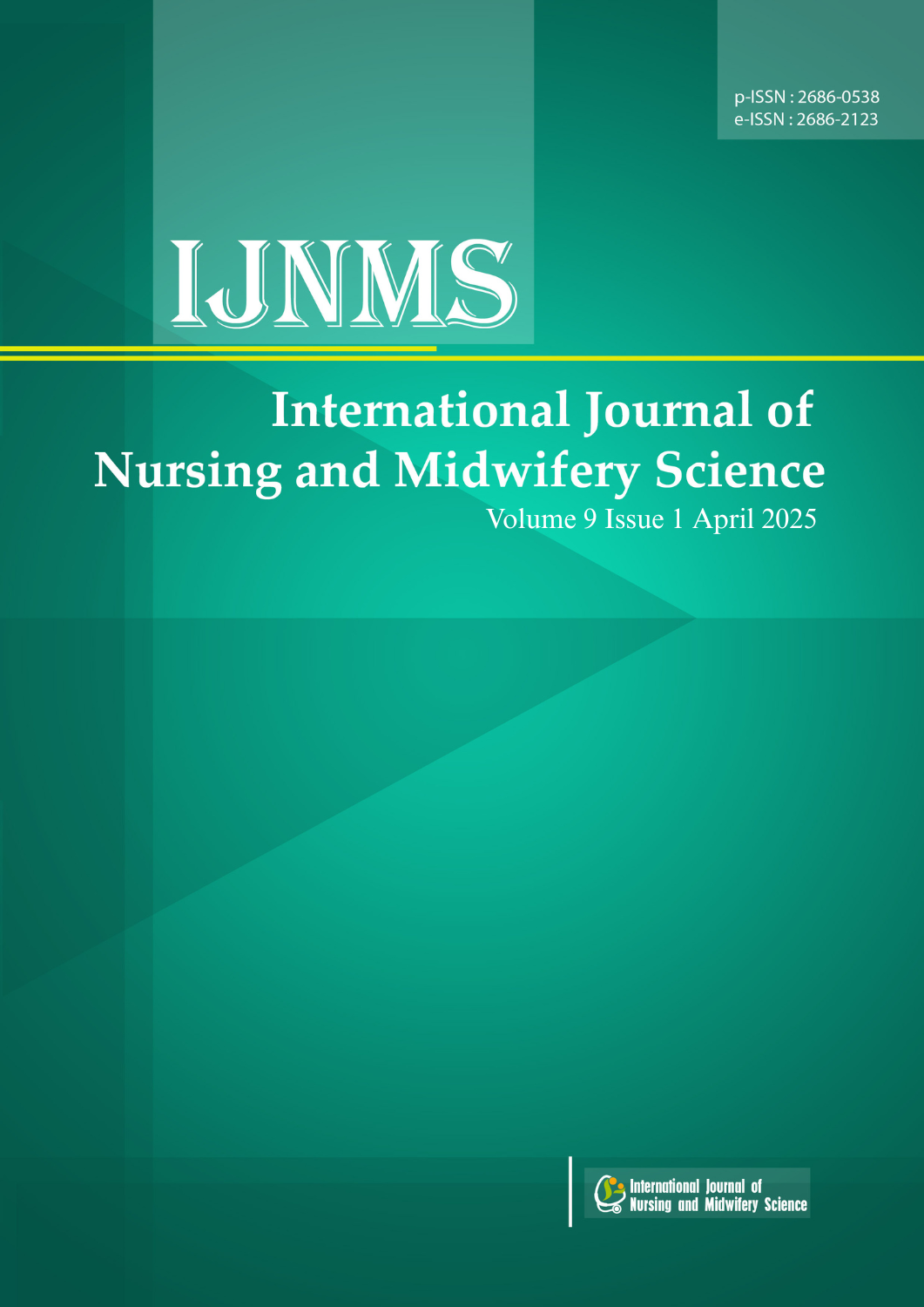GRADE ANKLE BRACHIAL INDEX (ABI) AS A PREDICTOR OF PERIPHERAL ARTERY DISEASE (PAD) IN MELLITUS PATIENTS
DOI:
https://doi.org/10.29082/IJNMS/2025/Vol9/Iss1/682Keywords:
ABI, PAD, Diabetes mellitusAbstract
Peripheral Artery Disease (PAD) often occurs in diabetes mellitus patients. PAD can be detected early by measuring the Ankle Brachial Index (ABI). ABI measurement should be important for all DM clients and all clients at risk of DM but is often ignored, causing PAD. The purpose of this study was to determine the Ankle Brachial Index (ABI) as a predictor of Peripheral Artery Disease (PAD) in patients with diabetes mellitus. The design of this study was descriptive with an observational study approach. The population in this study were all 113 diabetes mellitus clients in July 2024. The sampling technique used purposive sampling so that 100 people were obtained who met the inclusion and exclusion criteria. The research instrument used a digital tensiometer and observation sheet. Data analysis used frequency distribution. The results showed that the normal ankle brachial index value was 40 people (40%), respondents who experienced moderate PAD were 28 people (28%), mild PAD 16 people (16%), ABI tolerated 15 people (15%), and hardening of the arteries 1 person (1%). Data analysis suggested that almost half of the respondents had ankle brachial index PAD values consisting of moderate PAD and mild PAD. Moderate PAD occurs in obese diabetes mellitus patients and those who have suffered from diabetes mellitus > 5 years, and mild PAD occurs in those who have suffered from diabetes mellitus > 5 years and have a history of hypertension.
Downloads
References
Hariyono. (2020). Buku Ajar Asuhan Keperawatan Sistem Cardiovaskuler Untuk Profesi Ners. http://repo.stikesicme-jbg.ac.id/4813/1/3. Buku Ajar Cardio.pdf
Hati, Y., & Muchsin, R. (2021). Senam Kaki Untuk Melancarkan Airan Darah Perifer Peserta Diabetes Mellitus Tipe 2. JUKESHUM: Jurnal Pengabdian Masyarakat, 1(2), 71–77. https://doi.org/10.51771/jukeshum.v1i2.158
Hidayat, A. A. (2021). Metode Penelitian Keperawatan dan Tenik Analisis Data (1st ed.). Jakarta: Salemba Medika.
Hoda, F. S., Sani Mahoklory, S., & Elferson Lusi, O. (2019). Pengaruh Terapi Senam Kaki Terhadap Sensitivitas dan Perfusi Jaringan Perifer Pasien Diabetes Mellitus di Ruangan Instalasi Rawat Inap RSUD Prof. Dr. W. Z. Johannes Kupang. Keperawatan Dan Kesehatan Masyarakat, 8(2), 2598–4217.
Ismail, M. T., Hariawan, H., Lutfie, F. F. A., Nugroho, D. B., Susanti, V. Y., Anggraeni, V. Y., Kadafi, S. N., Ayuningtyas, R., Tarigan, T., Triatmaja, R., Artayasa, I. P. A., Ramadhan, G., & Hidayat, S. (2021). Prevalence and Risk Factors of Peripheral Arterial Disease in type 2 Diabets Mellitus in Yogyakarta, Indonesia. ACI (Acta Cardiologia Indonesiana), 7(2), 5. https://doi.org/10.22146/jaci.v7i2.3520
Kartikadewi, A., Setyoko, S., Wahab, Z., & Andikaputri, K. (2022). Ankle Brachial Index pada Penderita Diabetes dan Non Diabetes, dan Hubungannya dengan Aktivitas Fisik dan Perilaku Merokok. Jurnal Kedokteran Dan Kesehatan, 18(1), 57. https://doi.org/10.24853/jkk.18.1.57-68
Maryunani, A. (2018). Perawatan Luka (Modern Woundcare) Terlengkap dan Terkini. In Media.
Nadrati, B., & Supriatna, L. D. (2021). Buerger Allen Exercise Dan Ankle Brachial Indeks (ABI) Pada Penyandang Diabetes Melitus. Pekalongan: Nasya Expanding Management.
Nasution, W. W., Heryaman, H., Martha, J. W., & Ridwan, A. A. (2019). Clinical Manifestation of Peripheral Artery Disease in Type 2 Diabetes Melitus with Ankle Branchial Index Measurement. Journal of Medicine & Health, 2(3), 847–855. https://doi.org/10.28932/jmh.v2i3.1224
Nurarif, A. H., & Kusuma, H. (2016). Asuhan Keperawatan Berdasarkan Diagnosa Medis & NANDA NIC – NOC. Yogyakarta: Mediaction.
Priyantini, D., Ambar, N., Prinka, S., & Hanggitriana, A. (2022). Indeks Massa Tubuh Pada Penderita Diabetes Melitus Dengan Nilai Ankle Brachial Index. Jurnal Ilmiah Keperawatan Stikes Hang Tuah Surabaya, 17(2), 144–149.
Purwandari, C. A. A., Wirjatmadi, B., & Mahmudiono, T. (2022). Faktor Risiko Terjadinya Komplikasi Kronis Diabetes Melitus Tipe 2 pada Pra Lansia. Amerta Nutrition, 6(3), 262–271. https://doi.org/10.20473/amnt.v6i3.2022.262-271
Puspitasari, M., Mahmuda, I. N. N., Chandra, I. E. F., & Najib, Y. A. (2023). Hubungan Kadar Hba1c dan Kolesterol Total dengan Kejadian Peripheral Arterial Disease pada Pasien Diabetes Mellitus Tipe 2. Syntax Literate ; Jurnal Ilmiah Indonesia, 8(11), 6416–6423. https://doi.org/10.36418/syntax-literate.v8i11.13930
Rahayu, T. G. (2023). Analisis Faktor Risiko Terjadinya Stroke Serta Tipe Stroke. Faletehan Health Journal, 10(01), 48–53. https://doi.org/10.33746/fhj.v10i01.410
Sirait, C. N., & Mustofa, S. (2021). Diagnosis dan Penatalaksanaan Penyakit Arteri Perifer. Majority, 10(1), 1–10. http://repository.lppm.unila.ac.id/id/eprint/34916
Supriyadi, Dewi, N., Hamzah, P., & Selwir, E. W. (2019). Nilai Ankle Brachial Index Pada Penderita Diabetes Melitus Tipe 2. Jurnal Penelitian Keperawatan, 5(2). https://doi.org/10.32660/jpk.v5i2.402
Tampubolon, L. F., Ginting, A., & Saragi Turnip, F. E. (2023). Gambaran Faktor yang Mempengaruhi Kejadian Penyakit Jantung Koroner (PJK) di Pusat Jantung Terpadu (PJT). Jurnal Ilmiah Permas: Jurnal Ilmiah STIKES Kendal, 13(3), 1043–1052. https://doi.org/10.32583/pskm.v13i3.1077
Tjandra, K. J. C., Martin, A., Drew, C., Lestari, M., & Debora, E. (2023). Hubungan antara faktor GDP dengan kejadian PAD pada pasien Diabetes Melitus tipe 2 di RSUP Prof Dr.R.D.Kandou Manado. Jurnal Kesehatan Tambusa, 4 (3)(September), 2342–2346.
WHO. (2022). World Health Statistics 2022.
Widiastuti, L., Wati, L., Siagian, Y., & Sitindaon, S. H. (2022). Deteksi Dini Peripheral Arterial Disease pada Penderita Diabetes Mellitus Tipe 2. Media Karya Kesehatan, 5(1), 15–31. https://doi.org/10.24198/mkk.v5i1.35384
Downloads
Published
Issue
Section
License
Copyright (c) 2025 Ima Rahmawati, Kend Ramadio Rimba Syah Yogha

This work is licensed under a Creative Commons Attribution-ShareAlike 4.0 International License.
Authors who publish with IJNMS agree to the following terms
- Authors retain copyright licensed under a Creative Commons Attribution-ShareAlike 4.0 International License that allows others to share the work non-commercially with an acknowledgement of the work's authorship and initial publication in this journal.
- Authors are permitted and encouraged to post their work online (e.g., in institutional repositories or on their website) prior to and during the submission process, as it can lead to productive exchanges, as well as earlier and greater citation of published work (See The Effect of Open Access). Authors can archive pre-print and post-print or publisher's version/PDF.









_IJNMS.png)






